

Thai Forest Tradition. The Thai Forest Tradition is a tradition of Buddhist monasticism within Thai Theravada Buddhism.

Practitioners inhabit remote wilderness and forest dwellings as spiritual practice training grounds. Maha Nikaya and Dhammayuttika Nikaya are the two major monastic orders in Thailand that have forest traditions. The Thai Forest Tradition originated in Thailand, primarily among the Lao-speaking community in Isan.
The Thai Forest Tradition emphasizes direct experience through meditation practice and strict adherence to monastic rules (vinaya) over scholastic Pali Tipitaka study. Forest monks are considered to be meditation specialists. Adherents model their practice and lifestyle on those of the Buddha and his early disciples. Perhaps its most widely known representative was Ajahn Chah and in the UK Ajahn Sumedho. Origins[edit] [edit] In Thailand, Buddhism plays a central role in society.
Teachers[edit] Pali Canon[edit] Dhammayuttika Nikaya. Vajirañāṇo Bhikkhu (later King Mongkut of Siam), the founder of Dhammayuttika Nikaya The Dhammayuttika Nikaya or Thammayut Nikaya (Thai: ธรรมยุติกนิกาย, ธรรมยุต; Khmer: ធម្មយុត្តិក និកាយ) is an order of Theravada Buddhist monks in Thailand and Cambodia.

Its name is derived from the Pali dhamma ("teachings of the Buddha") + yutti (in accordance with) + ka (group). Founding in Thailand[edit] The Dhammayuttika Nikaya, or simply Thammayut, began in 1833 as a reform movement led by Prince Mongkut, a son of King Rama II. Thammayut remained a reform movement until passage of the Sangha Act of 1902, which formally recognized it as the lesser of Thailand's two Theravada denominations.[1] Prince Mongkut was a bhikkhu (ordination name: Vajirañāṇo) for 27 years (1824–1851) before becoming the King of Siam (1851–1868). Ajahn Sao Kantasīlo. Phra Ajahn Sao Kantasilo Mahathera (1861–1941) was a monk in the Thai Forest Tradition of Theravadin Buddhism.
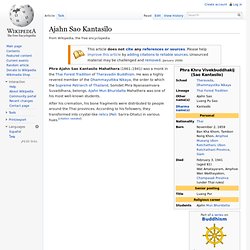
He was a highly revered member of the Dhammayuttika Nikaya, the order to which the Supreme Patriarch of Thailand, Somdet Phra Nyanasamvara Suvaddhana, belongs. Ajahn Mun Bhuridatta Mahathera was one of his most well-known students. After his cremation, his bone fragments were distributed to people around the Thai provinces. According to his followers, they transformed into crystal-like relics (Pali: Sarira-Dhatu) in various hues. [citation needed] Mun Bhuridatta. Ajahn Mun Bhuridatta Thera (Thai: มั่น ภูริทตฺโต, RTGS: Man Phurithatto; Lao: ຫຼວງປູ່ມັ່ນ ພູຣິທັຕໂຕ), 1870–1949, was a Thai Buddhist monk of Lao descent who is credited, along with his mentor, Phra Ajahn Sao Kantasilo Mahathera, with establishing the Thai Forest Tradition (the Kammatthana tradition) that subsequently spread throughout Thailand and to several countries abroad.
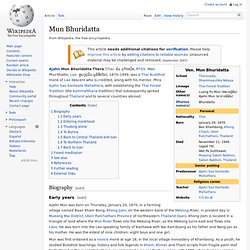
Biography[edit] Early years[edit] Ajahn Mun was born on Thursday, January 20, 1870, in a farming village named Baan Kham Bong, Khong Jiam, on the western bank of the Mekong River, in present day Si Mueang Mai District, Ubon Ratchathani Province of northeastern Thailand (Isan). Khong Jiam is located in a triangle of land where the Mun River flows into the Mekong River, as the Mekong turns east and flows into Laos. He was born into the Lao-speaking family of Kanhaew with Nai Kamduang as his father and Nang Jan as his mother. Mun was first ordained as a novice monk at age 16, in the local village monastery of Khambong.
Ajaan Maha Boowa. Many of Ajaan Maha Boowa's books are also available free of charge, in both print and electronic form, from Wat Pah Baan Taad, his forest monastery in Thailand.
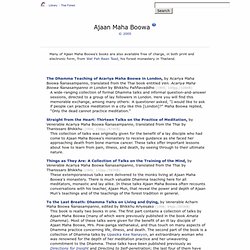
The Dhamma Teaching of Acariya Maha Boowa in London, by Acariya Maha Boowa Ñanasampanno, translated from the Thai book entitled Ven. Acariya Maha Boowa Ñanasampanno in London by Bhikkhu Paññavaddho(1995; 109pp./326KB) A wide-ranging collection of formal Dhamma talks and informal question-and-answer sessions, directed to a group of lay followers in London. Here you will find this memorable exchange, among many others: A questioner asked, "I would like to ask if people can practice meditation in a city like this [London]? " Maha Boowa replied, "Only the dead cannot practice meditation. " Ajahn Chah. Chah Subhaddo (Chao Khun Bodhinyana Thera) (Thai: ชา สุภัทโท, alternatively Achaan Chah, occasionally with honorific titles Luang Por and Phra; 17 June 1918 – 16 January 1992) was an influential teacher of the Buddhadhamma and a founder of two major monasteries in the Thai Forest Tradition.
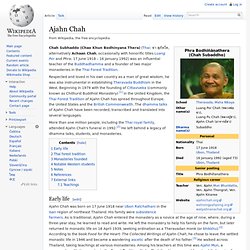
Respected and loved in his own country as a man of great wisdom, he was also instrumental in establishing Theravada Buddhism in the West. Beginning in 1979 with the founding of Cittaviveka (commonly known as Chithurst Buddhist Monastery) [1] in the United Kingdom, the Thai Forest Tradition of Ajahn Chah has spread throughout Europe, the United States and the British Commonwealth. The dhamma talks of Ajahn Chah have been recorded, transcribed and translated into several languages. More than one million people, including the Thai royal family, attended Ajahn Chah's funeral in 1992.[2] He left behind a legacy of dhamma talks, students, and monasteries. Early life[edit] Abhayagiri Monastery. Ajaan Lee. Thanissaro Bhikkhu. Maha Nikaya. "Maha Nikaya" (literal translation: Great Collection) refers to one of the two principal sects of modern Thai Buddhism.
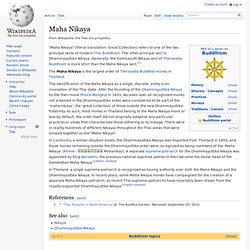
The other principal sect is Dhammayuttika Nikaya. Generally, the Dahmayutti Nikaya sect of Theravada Buddhism is more strict than the Maha Nikaya sect.[1]